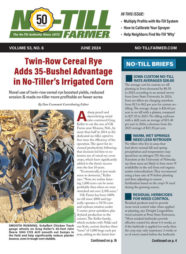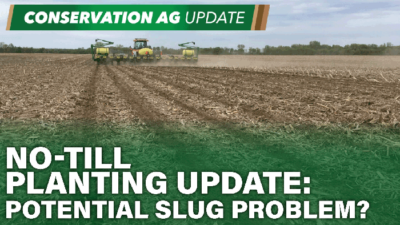Drought in April is not usually a problem for Pennsylvania farmers. However, now that many parts of the state had warm temperatures and a lack of rainfall, how should herbicide programs be altered? With many 10-day forecasts predicting limited rainfall, some are wondering if residual herbicides included with burndown programs will be effective. Therefore, should they even be included in the burndown programs if droughty conditions persist?
Dry weather can affect both soil-applied and postemergence herbicide performance. All soil-applied herbicides require rainfall to mobilize them for effective weed control. In general, rainfall should occur within 7 to 10 days after application or before weed emergence. As a general rule of thumb, ½ inch of rain is considered the minimum depending on current soil moisture levels and the herbicide used; ¾ to 1 inch is ideal.
More water soluble products such as Callisto, Outlook, Spartan/Authority and metribuzin require less rainfall (1/4 to 1/3 inch) to activate them while the less mobile materials (Balance Flexx, Prowl, atrazine, simazine, Valor, Zidua) and deeper germinating weeds (e.g. yellow nutsedge, cocklebur, velvetleaf, ragweed, etc.) will require more rainfall for effective mobilization and activation into the seed germination zone. Keep in mind that many small seeded annual weeds can germinate with minimal moisture. Thus, sometimes you may observe weed emergence before enough rainfall has incorporated the herbicide for effective kill.
If 10-14 days have passed without rainfall following a pre treatment and weeds are starting to break, start planning for a post herbicide rescue application. Some "reach back" or "recharge" can be expected on small annual weeds (esp. broadleaves) with some herbicides when rainfall occurs, although depending on this may be a little like gambling. In particular, the HPPD (Group 27) herbicides (Acuron, Balance, Corvus, Lexar, Lumax, etc.) tend to have better "reach back" potential than some other herbicides and escaped grass control is probably of greater concern.
The Group 5 herbicides like atrazine, simazine and metribuzin will also control small emerged susceptible broadleaves via root uptake. Since there are several herbicides, including residual products, that can be applied after planting up until corn and weeds reach a certain size or growth stage, it might be best to wait until the crop is planted and consider modifying your residual herbicide program at that point, if possible.
Burndown Herbicides, Drift & Vineyards
Some vineyard owners are reporting that grapes are starting to break buds. It is likely that herbicides can cause extensive damage to grapevines between bud break and fruit set. Therefore, lately we have received calls asking for burndown herbicide suggestions for fields that are adjacent to sensitive crops such as vineyards or specialty crops. Most broadleaf plants (e.g., grapes, vegetables, fruit crops, ornamentals, certain trees, non-tolerant soybeans, tobacco, etc.) are extremely sensitive to plant growth regulator (PGR) herbicides. PGR herbicides include phenoxy, benzoic and pyridine classes of compounds.
The most common PGR herbicides used are those containing 2, 4–D or dicamba. But others, which have been documented as causing injury include picloram (e.g., Tordon), triclopyr (e.g., Garlon) and clopyralid (e.g. Stinger). All the PGR herbicides should be considered as potentially injurious to non-target sensitive plants as a result of spray drift. Herbicide formulations and vapor pressure are primary factors associated with the volatility of most PGR herbicides. In general, the higher the vapor pressure of a pesticide, the greater its tendency to volatilize.
Unfortunately, it is difficult to simply use their vapor pressure values to determine how much volatility will occur and thus cause off-target movement and injury. Many factors, including environmental issues, play a part in the overall potential for herbicides to volatilize. Temperature and relative humidity are important for volatility – high temperatures and very low relative humidity usually cause much more volatility. Though volatility is important, off-target movement of herbicides is also due to small spray droplet drift and/or temperature inversions.
Alternative Burndown Herbicide Options & Drift Reduction
Historically, many of the standard burndown herbicide programs have included 2,4-D, primarily to control glyphosate/ALS-resistant marestail and other weeds such as dandelion and winter annuals. And with more XtendFlex and Enlist E3 soybean varieties being sold, dicamba- and 2,4-D choline-products, respectively, are being used more in burndown programs. However, if crop production fields are near sensitive crops or areas, both herbicides have the potential to cause problems even early in the season if grapes or sensitive trees are starting to bud or break dormancy. Furthermore, glyphosate drift can cause problems in these settings, and glyphosate-resistant weed species will not be controlled.
In cases like this, some alternative herbicides for burndown include paraquat (e.g., Gramoxone), glufosinate (e.g., Liberty 280), saflufenacil (e.g., Sharpen), and tiafenacil (Reviton). And depending on the type of weeds being controlled, other herbicide options (or their generic alternatives) such as Basis Blend, Harmony Extra, Canopy DF, metribuzin, Lorox, or others can provide some burndown activity. To improve the effectiveness of these products, especially during early spring conditions, make sure to use higher rates, include necessary adjuvants, use higher spray volumes (≥15 gpa), spray when weeds are small (3-5" tall) and actively growing; and apply during sunny days and warm temperatures (>50F daytime). Most of the soil-applied residual herbicides that are tank-mixed with burndown herbicides are not volatile and usually don’t cause problems to sensitive crops (unless severe drift occurs).
However, no matter what herbicide is being applied it is best to reduce drift and keep the spray in the target area. Some drift reducing suggestions include – use low-drift nozzles and specially developed drift control adjuvants, increase carrier spray volumes (e.g., 20 gpa), reduce spray rig ground speed, use wide angle nozzles that allow lower boom heights, spray in low wind conditions, and apply when the wind directions is away from the sensitive area.
Communication Key to Reduce Drift
DriftWatch by FieldWatch is now available to use in Pennsylvania. It is a free, online Voluntary Specialty Crops Registry designed to alert applicators about locations of sensitive areas. The stewardship tool allows for improved communication and collaboration between producers of specialty crops and pesticide applicators using a technology platform where producers can map their sites and provide contact information to pesticide applicators through an online mapping system. Go to the Fieldwatch website for more details and to register.
In collaboration with the USDA-funded North Central IPM Center, the Herbicide Drift Risk Management Special Project Group has developed a series of extension fact sheets written for specialty crop (e.g. grapes, vegetables, etc.) growers. Also, please consider completing this special survey. This survey aims to collect data on awareness of herbicide drift damage and herbicide application issues. Our goal is to help both grape growers and herbicide applicators by identifying if knowledge gaps exist; if identified, these will be used as future focus points for Penn State Extension specialists.







Post a comment
Report Abusive Comment